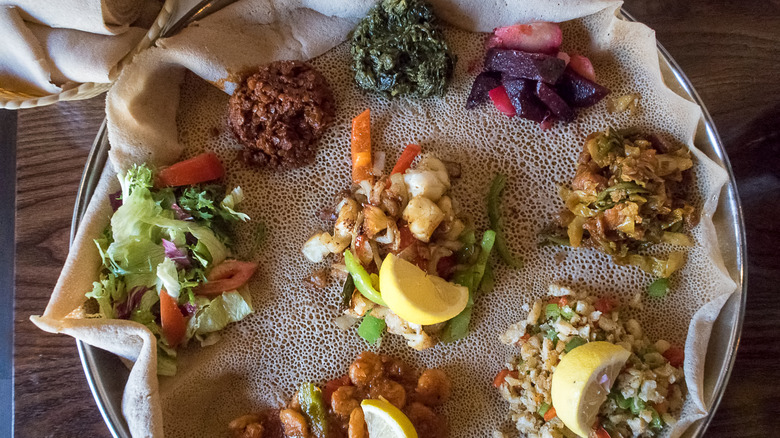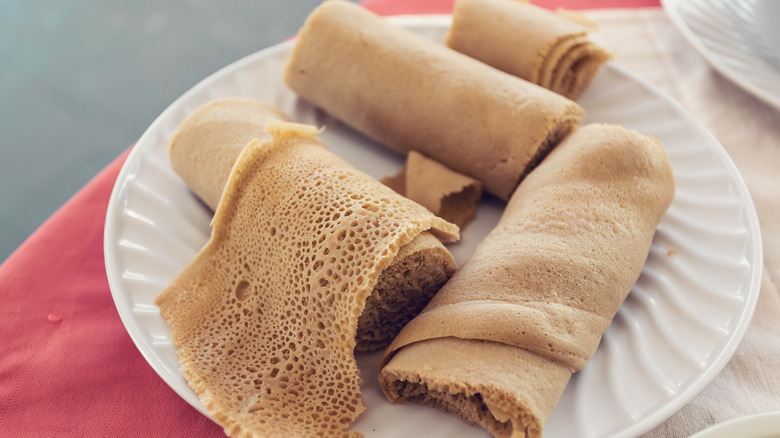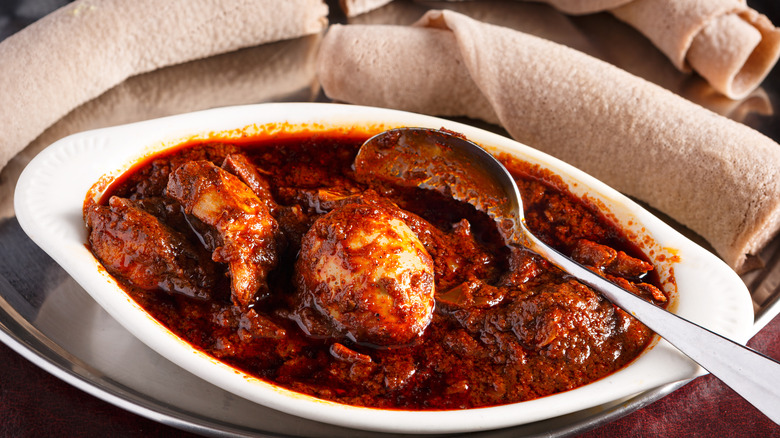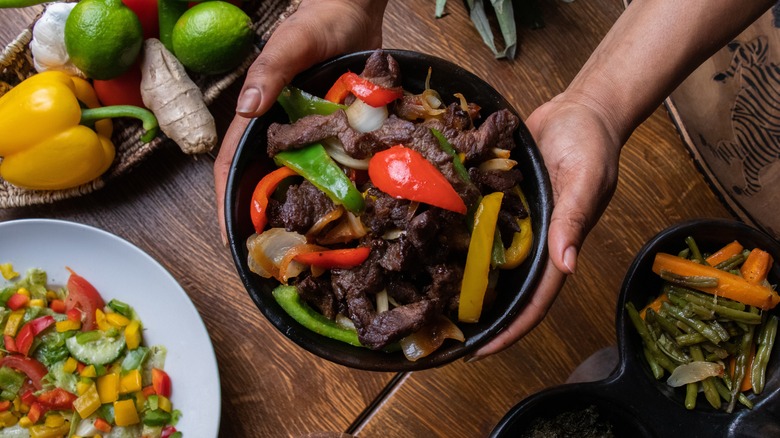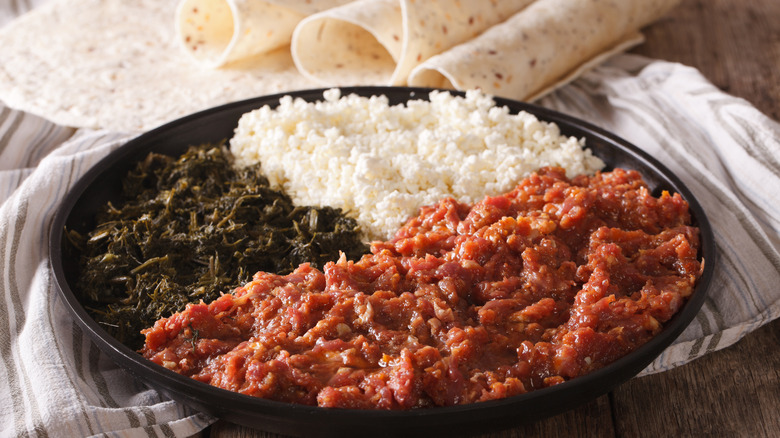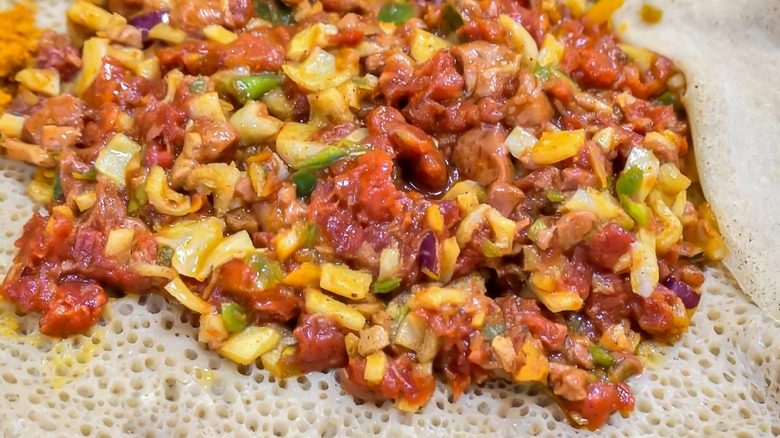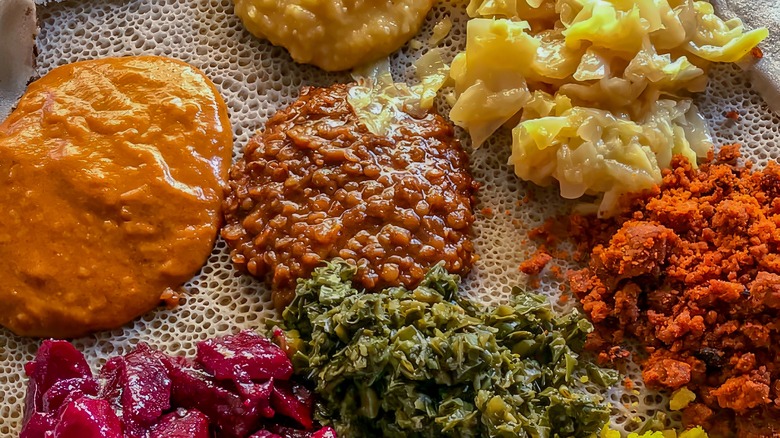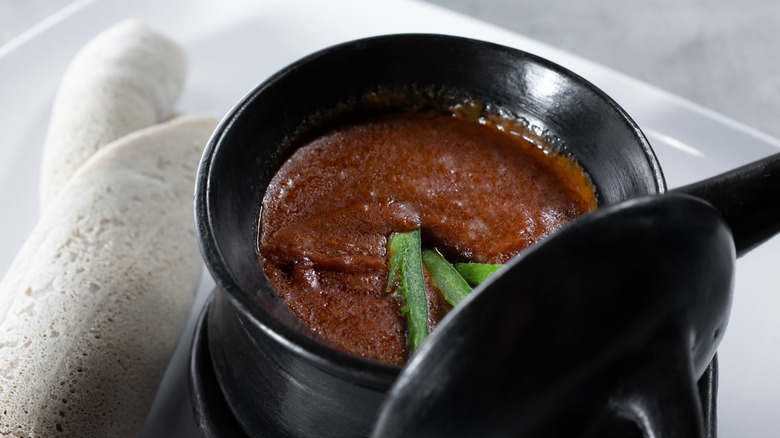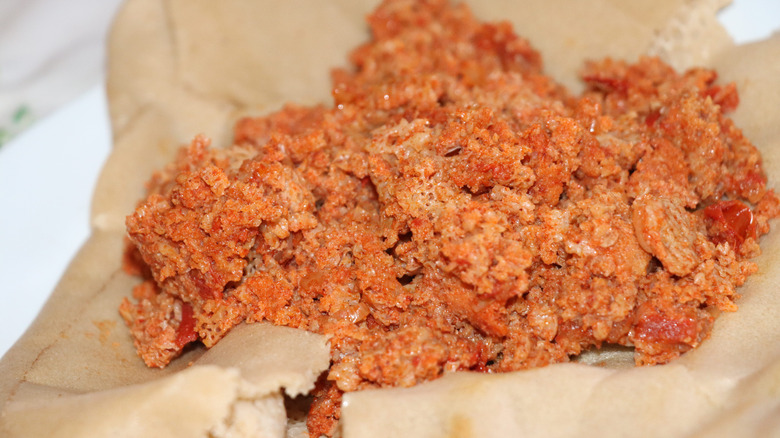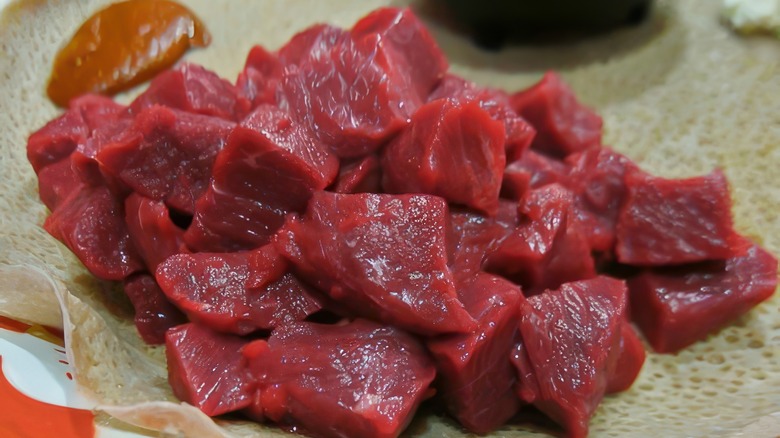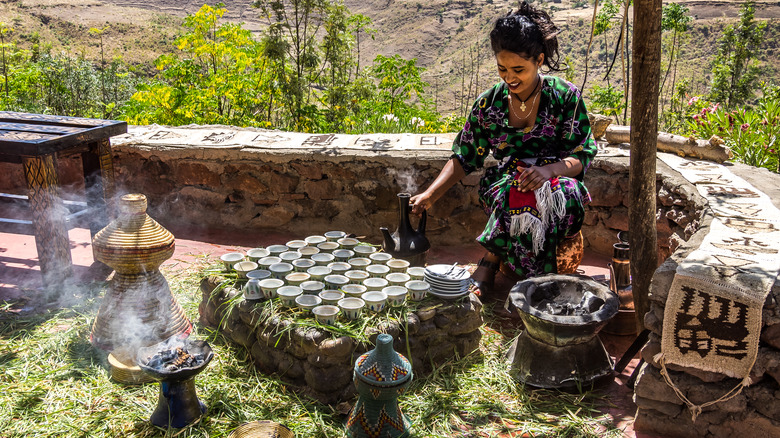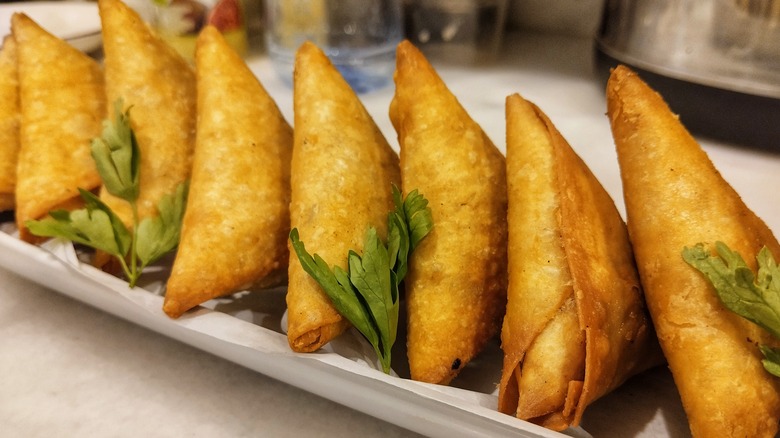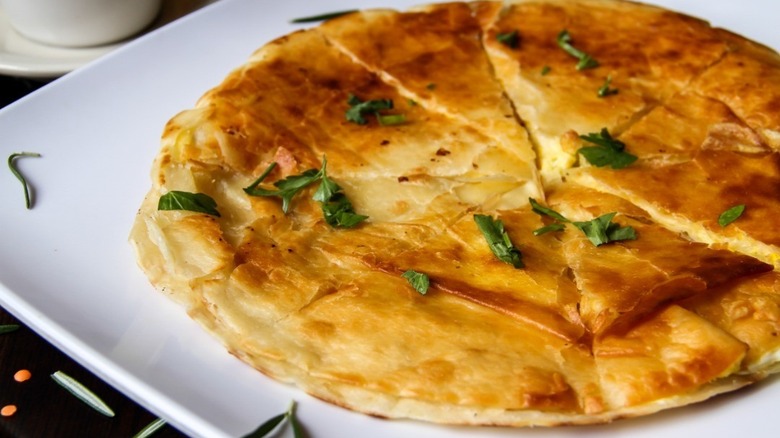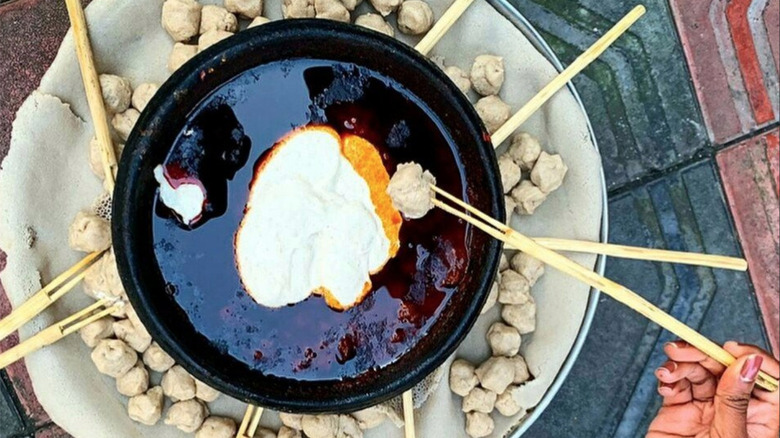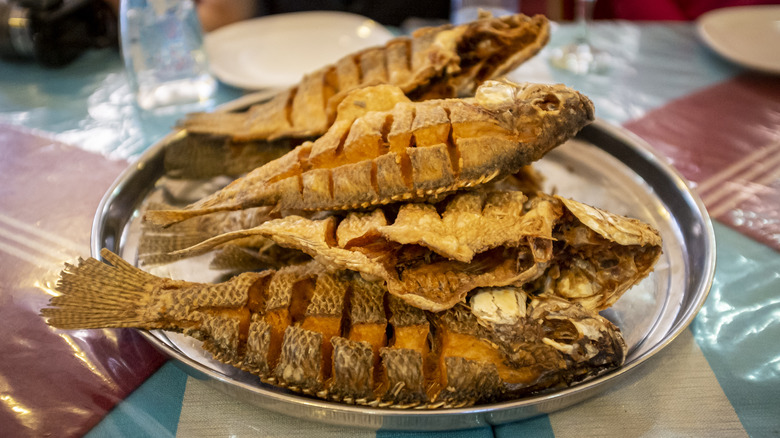14 Essential Ethiopian Dishes And Drinks
If you're looking for a memorable way to spend an evening with food-loving friends, consider dinner at an Ethiopian restaurant. This unique cuisine has something for everyone — hearty meat stews, traditional wines, and vegan dishes so richly flavored even carnivores will crave them. But one word that can never be used to describe Ethiopian food is bland: As a central node along historic spice trading routes, Ethiopia adopted flavorings from all over the world, such as chiles from the New World (via Portugal), ginger from the Far East, along with Indian spices such as cinnamon and fenugreek, all of which continue to be lavishly used by cooks. Generous quantities of onions — often cooked down to a soft paste — also provide a savory foundation for many dishes. So while few Ethiopian dishes are tongue-searingly hot, you can always count on them to be deeply flavored and varied. You'll be hard-pressed to go to an Ethiopian restaurant and want to order just one thing.
And the good news is you won't have to. Ethiopian food is meant to be shared. By tradition, meals are enjoyed communally and are served on a large, round platter. All diners eat from this common platter with their hands (right hand only, please) and are expected to wash their hands before eating. This means everyone can help themselves to anything they want, and diners get to sample a little bit of everything. Here are some essential dishes you need to know about and try.
Injera
Injera, a spongy, tangy, crepe-like flatbread, is foundational to Ethiopian cuisine, both in a literal and metaphorical sense. In most cases, injera forms the literal base of the meal — the large platter on which your food is served will be lined with a round of injera, with the rest of the food placed on top of it. Injera not only serves as an edible plate liner but an eating utensil. Meals come with a basket of folded injera, and you tear off pieces of it and use them to pick up whatever morsel you feel like tasting next. And after that, of course, you eat the injera itself, which has absorbed the food's flavorful seasonings while keeping them off your fingers.
Injera is distinctive in other ways as well. For one, it's traditionally made from teff, a small, gluten-free grain native to Ethiopia (though many English-language recipes also include wheat flour to make the tricky batter — much like a thin pancake batter — easier to handle). Second, it gets its leavening (and spongy texture and uniquely tangy flavor) through fermentation, much like a sourdough. And because you'll probably get a taste of injera with every bite you take, its distinctive tang is one of the defining flavors of Ethiopian cuisine.
Doro wat
Wots, or stews, are a common Ethiopian dish, and one of the more common versions you'll see on restaurant menus is doro wot, or chicken stew. But put aside all thoughts of chicken pot pie filling or other familiar preparations — doro wot is proof that ordering chicken doesn't mean settling for bland or familiar.
Like many Ethiopian dishes, doro wot is flavored with berbere, a spice mix whose ingredients can include chile powder, paprika, fenugreek, cardamon, coriander, and more. (If you want to try your hand at making your own doro wot or other Ethiopian stews, you can order berbere online or make your own. Onions, garlic, and ginger round out the sauce. Besides pieces of bone-in chicken, doro wot also includes hard-boiled eggs. This hearty, richly flavored dish is often the featured dish at holiday celebrations. And like many special-occasion dishes, it comes with special rules: By tradition, diners should enjoy the sauce and eggs with injera first before helping themselves to the chicken pieces.
Tibs
If you're a fan of fajitas, you'll want to try tibs, another classic of the Ethiopian kitchen. It's basically small slices or chunks of meat (either beef or lamb) quick-fried in butter with onions and garlic, but can take on a range of flavorings, from super-spicy to mild. Some versions get an extra flavor boost from spiced butter, an Ethiopian pantry staple consisting of clarified butter simmered with spices such as coriander, cinnamon, and cloves.
By tradition, tibs is a celebration food, often served in honor of special events or special guests. Today, however, it's a common party food, ordered whenever diners feel like having a good time. If you travel to Ethiopia and order tibs — no doubt the best way to experience the dish in its original form — you may see something surprising: cooks slicing pieces of meat straight off a cow or lamb carcass hanging right by the restaurant entrance. Don't let this put you off — it's your reassurance you're going to get the freshest meat possible.
Kitfo
Another distinctively meaty Ethiopian favorite is kitfo, finely minced, super-lean beef tossed with warmed butter and mitmita, an intensely flavored spice mix that can contain cumin, allspice, chiles, as well as other spices. Yes, this means the meat is served virtually raw — think of it as an Ethiopian analog to steak tartare. (If you're concerned about the safety of eating raw beef, it's worth knowing that many cooks use only meat from between the shoulders of a steer, which is traditionally thought to be free of disease-bearing worms.) But to play it safe, you can also order kitfo cooked, in which case the meat is heated more thoroughly with the spiced butter mixture.
Kitfo is traditionally esteemed for its high nutritional value and seen as a celebration food. Because of its richness, however, it's often served with other dishes such as minced spinach or alb, a crumbly cheese somewhat like cottage cheese. These extras offer a welcome contrast to the richness of the meat and make the already substantial dish into a full meal.
Dulet
Conscientious meat eaters, as well as those engaged in the hard work of raising livestock, know the importance of not wasting meat — failing to use everything a slaughtered animal has to offer is not only insulting to the animal that gave its life, but a waste of valuable food that could provide yet more meals and nutrition. Western cooks and diners have become increasingly aware of this in recent years as nose-to-tail dining has gained popularity.
But this concept is far from new, and Ethiopian cooks have been implicitly following the principles of nose-to-tail cooking all along. A case in point is dulet, a hearty dish of multiple cuts of meat — including tripe, liver, and lean meat — cut into small pieces and cooked together with a flavorful mixture of butter, chile, cardamon, onions, and pepper. The contrasting textures, from the chewy tripe and creamy liver, combine with the spices into a tantalizing whole. Even if you're not a huge fan of organ meat, this deeply flavored, protein-rich dish might change your mind.
Beyaynetu
While Ethiopian cooking celebrates meat in all forms, it also has a long tradition of vegetarian cooking. This is in part thanks to the country's Orthodox Christian population, which observes a large number of fast days throughout the year (for instance, meat is traditionally not eaten on Wednesdays, Fridays, or certain holidays, and priests and monks are required to fast up to 250 days a year). On fast days, the faithful don't fast completely but rather abstain from meat and dairy. This doesn't mean, however, that fast days are a vast flavor-free zone for observant Christians in Ethiopia. Far from it: Ethiopian vegetarian cooking, like the country's meat cookery, makes generous use of spices and spice mixes, making its meatless cooking so colorful and varied that many diners won't miss the meat.
If you're a vegetarian, or an omnivore who wants something lighter to balance out a rich meat dish, beyaynetu is exactly what you need. Translating literally as "a bit of every type," it's a colorful sampling of dishes that can include spiced lentils, potatoes, vegetable stews, and more. It's not only attractive to look at, but offers a variety of flavors and textures that can remind you how much flavor potential vegetables really have.
Shiro
One of Ethiopia's many meatless specialties is shiro, a highly seasoned purée of chickpeas or other legumes. While not much to look at (it looks exactly how you'd expect a bunch of mashed beans to look), there's far more to it than meets the eye. Like most Ethiopian dishes, it's supercharged with flavor. Recipes vary with cooks and regions, but a typical example includes garlic, tomatoes, berbere (Ethiopian spice mix), ginger, turmeric, and cinnamon. Versions can be thick (rather like mashed potatoes) or runny like a sauce.
While this hearty dish is popular on fast days, it's not seen as an abstemious dish by any means. Indeed, some variants — such as tegabino shiro, which is thickened with flour and served still bubbling in a tiny clay pot — are downright festive in their presentation. Shiro can also be served for breakfast, mixed with shredded injera (Ethiopian fermented flatbread) — this makes the already hearty purée an even more fortifying way to start a busy day. For home cooks who want to try their hand at shiro, an easy shortcut to getting a super-smooth texture is to use chickpea flour instead of cooked, mashed chickpeas.
Dabbo firfir
Almost every bread-loving culture has developed dishes that not only make use of, but elevate, leftover bread — such as Italian panzanella or Middle Eastern fattoush (salads featuring stale cubes of Italian bread or toasted pita pieces, respectively), or even our familiar bread pudding or bread strata. So it's not surprising that many popular Ethiopian dishes feature injera, the country's signature fermented flatbread, as their central ingredient. These dishes, known as fitfit (or firfir) consist of torn injera tossed with sauces or stewed foods such as shiro, or spiced legume purée. For Ethiopian cooks, firfir is an ingenious and flavorful way to get more mileage out of foods they probably already have on hand in their kitchens.
A version of firfir you're likely to find in Ethiopian restaurants in the U.S. is dabbo firfir, a modest dish of crumbled injera tossed with melted butter and berbere, a traditional Ethiopian spice blend. It doesn't look or sound like much, but looks can be deceiving — berbere is deeply flavorful, and combined with tangy injera, the whole becomes more than the sum of its parts. Often served with plain yogurt, it makes for a flavorful and filling side dish or light meal on its own.
Tere siga
If you're a hard-core carnivore and resent the way vegetables and sauce get in the way of your meat in stews or other preparations, tere siga needs to be on your radar the next time you go out for Ethiopian food. This popular Ethiopian specialty consists simply of chunks of raw beef, often cut directly from a carcass, served with a hot-chile-laced spice blend called mitmita along with a hot mustard sauce called senafich for dipping.
While tere siga, like most Ethiopian dishes, is served with injera, it also comes with a knife so diners can slice off bite-sized pieces at will. One legend states that it was first devised by military operatives in the 16th century as a way for soldiers to get their protein fix without lighting fires and being detected by enemy forces. The dish's popularity today makes an odd kind of sense in light on the heavily vegetarian diet kept by Ethiopia's majority Christian population. While observant Christians do forgo meat and dairy for nearly half the days of the year, most are not strict vegetarians. So on the days when their faith allows meat, they're happy to go all in.
Coffee
We know: You can get coffee in almost any restaurant of any time nearly anywhere you go in the world. But if you're a serious coffee fan, you probably already know that Ethiopian coffee is special and sought after. Moreover, Ethiopia is the birthplace of coffee culture, and 9th-century Ethiopian cooks were the first to cultivate and brew it. Arabica coffee — the most esteemed type — is native to Ethiopia, and while it still grows wild there, Ethiopian farmers have devised numerous ways of cultivating and preparing it over the years.
And while coffee has long been part of the Ethiopian landscape, it's never been taken for granted. The traditional Ethiopian coffee ceremony, which you can experience yourself if you find the right restaurant, even in the U.S., shows the culture's reverence for coffee. First, the serving table is scattered with fresh grass to evoke the outdoors. Next, the hostess lights a stick of incense before showing the guests a pan of green coffee beans, which she roasts over an open flame before grinding. Water is then brought to a boil in the coffee pot, traditionally a round clay pot with a long neck and spout, before the ground coffee is added and heated. The strong, fresh brew is served with sugar in tiny cups — a perfect way to cap off a rich Ethiopian meal and appreciate coffee as it was originally intended to be enjoyed.
Sambusas
Along the lines of Indian samosas, Ethopian sambusas are flaky, fried pastries that wrap up like tiny triangular brown paper packages you can mail to your belly. If they look familiar, there's a serious chance you enjoyed this nostalgic treat as a kid. (Lucky you.)
Typically filled with spiced lentils, chicken, beef, or cottage cheese, this portable Ethiopian treat is a close cousin of neighboring Somalia and Kenya, where sambusas are often made with spiced lamb. But before sambusas of any kind found their way to Ethiopia, they were crafted somewhere in a kitchen in the Middle East. Sometime during the 10th century, the first sambusas (called sambosas with an O back then) were noted in the writings of a historian from Iran, Abolfazl Beyhaqi. Apparently, he was really into his snacks.
These days, boundless DIY sambusas recipes feature wonton wrappers subbing in as the "pastry" crust, with all sorts of custom fillings finding a welcome place at the table. A traditional stewed lentil filling features onion, jalapeños, ginger, garlic, and warm spices. But judging by the long history of this dish, it seems it's only a matter of time before it reinvents itself for a new generation.
Fatira
Most of us would gladly hop aboard the street food train all around the world. But highly available Ethiopian fatira also dishes up a one-of-a-kind experience wherever breakfast is served.
A simple dough is portioned into balls, which are rolled out, and then often folded into squares to be cooked almost like pancakes. For breakfast, an egg and vegetable mixture is then added to the pan, with the cooked fatira placed on top until the eggs are done.
By itself, the wheat flour fatir pastry is typically enjoyed with honey for dipping. This is a popular treat in Ethiopia, especially for Muslims during the Eid al-Fitr celebration, marking the end of Ramadan's month-long daylight fast. Of course, it makes sense to celebrate Eid al-Fitr with dessert. Who wouldn't be down for a sweet honey sugar rush after four weeks of not eating while the sun's up? Practicing Muslims are actually prohibited from celebrating Eid without eating, so bottom's up with the Ethiopian fatira (at any time of year).
Ti'hilo
Fondue party, but bring the Ethiopian heat. Ti'hilo is a delicacy from the region of Tigray along the northern border of Ethiopia. It features bite-sized barley balls you pierce with a two-pronged stick, and then dip into hearty red gravy in a clay pot. The dish has yet to make a real splash anywhere other than Tigray, but, as its agent might say, it's in development. Maybe that has to do with the fact that it's not uncommon for someone else to roll the barley balls on command for you at a restaurant, sitting at the ready by your side.
Not only is barley a big seller around the world, it's particularly key in Ethiopian cooking, as one of the country's largest crops. Ti'hilo is made from a simple dough of roasted barley flour (Ethiopian beso) and water, and rolled into balls. The part of the dish that is cooked is the deep red sauce for dipping, which involves a combination of onions, tomato sauce, and the chili-spiced bebere seasoning blend. Toothpicks out — you've got yourself an appetizer.
Of course, if you really want to serve it authentically, the sauce pot and barley balls should be plated atop an enormous sheet of injera. Ethiopian beso helps calm gastritis, with barley offering a wealth of vitamins and nutrients to prevent cancer, regulate inflammation, and boost heart health. (We'll take all the Ti'hilo, please.)
Asa
Maybe you know Asa as the Nigerian pop star. But for our purposes, we're talking about asa as the Ethiopian term for fish. You'll find an entire host of dishes where asa is the star — sometimes featuring its big fried eyes and a toothy smile, looking at you from the center of your plate.
It's customary to eat the entire fish with your hands (it's also Ethiopian tradition to clean your plate, tail and all). Those crispy bits are what make any asa dish the highlight of the meal. Asa wot features a spicy white fish stew, often seasoned with the beautiful bebere spice blend flavors. Asa goulash serves up all the comfort of a spicy stew but with tomatoes and vegetables. (And always, injera.)
Also popular are asa tibs, a dish that's just like the meat version but made with fish. The fish is fried in bite-sized chunks, then tossed into sautéed onions, with citrus and jalapeños on the side for a little extra kick. It's also a really great way to enjoy an Ethiopian fish dish without having to deal with any of the bones. Or eye contact with your meal.

